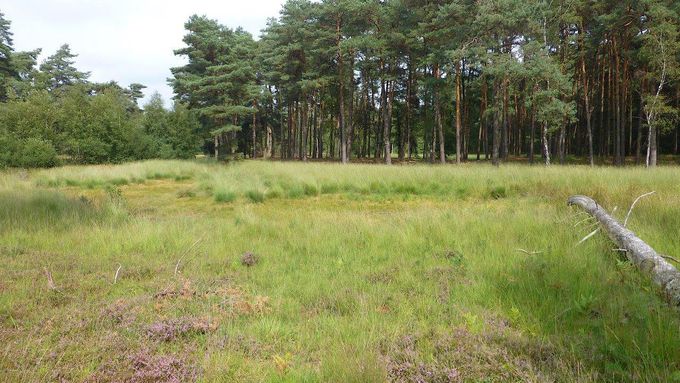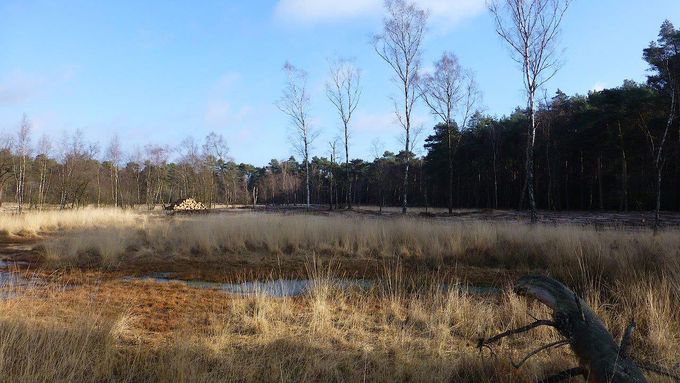Die Maßnahmenfläche im Bereich „Kleine Sonsbeck“ vor Beginn der Arbeiten © Norbert Neikes, Biologische Station Krickenbecker Seen
download picturemain content
Project of the month
#10/2019 Nature reserve Heidemoore
Renaturation in the “Brachter Grenzwald“
The nature reserve “Heidemoore” is part of the Special Area of Conservation “Wälder und Heiden bei Brüggen-Bracht”. It is a well-preserved complex of moorlands, inland dunes, bog ponds and birch bog forests, and is of statewide importance due to its outstanding portions of rare habitat types and biodiversity. Particularly noteworthy are the Atlantic dry heaths and moorlands with transition mires and quaking bogs. Here, many endangered species find the nutrient-poor conditions they need. The open, loose sand is used by sand lizards (Lacerta agilis) and smooth snakes (Coronella austriaca) for oviposition. In addition, crested newt (Triturus cristatus), natterjack toad (Bufo calamita), moor frog (Rana arvalis), pool frog (Pelophylax lessonae), and yellow-spotted whiteface (Leucorrhinia pectoralis) are found in the area.
The originally extensive inland dunes between the moorlands have been reforested with pines in the 20th century. As a result, the typical vegetation has been replaced and is only available on a small scale. Shading and evaporation of adjacent forests pose a threat to their survival. In particular, small moorlands can only be preserved if they are provided with sufficient buffer strips and combined to a system of interlinked biotopes. The aim of the measures which were carried out in the framework of the EU-funded LIFE Integrated Project “Atlantic Region DE” around the areas “Große Sonsbeck” and “Kleine Sonsbeck” in the Kaldenkirchener Grenzwald was therefore to restore the habitat types that have become rare in the area: dry sand heaths with Calluna and Genista (2310), inland dunes with open Corynephorus and Agrostis grasslands (2330) and European dry heaths (4030). The measures were carried out in cooperation with the Biological Station Krickenbecker Seen and the Lower Nature Conservation Authority of the district of Viersen.
At the end of October 2018, works started on site. On an area of about 2.5 hectares, pines including pollards were cleared. The tree stumps were milled off into the ground. Subsequently, the upper humus soil was removed, so that open sandy surfaces can develop as habitat for many valuable species of dunes and heaths again. The sod removal also leads to an elimination of nutrients, and thus to the restoration of nutrient-poor site conditions. In order to protect the remnants of rare plant species and not to remove them accidentally, staff of the Biological Station pegged these out prior to the intervention so that they were spared.
For the further development of the dunes and heaths, maintenance work will be done in the next few years to eliminate emerging woods. In addition, sheep and goats will graze the area. In a few years, the bald pioneer areas will develop into heathland. Sand lizard and smooth snake, but also the woodlark (Lullula arborea) and many other species will benefit from these changes. Visitors to the area can also experience the transformations in the dune landscape via a hiking trail which runs along the area.
The Biological Station Krickenbecker Seen had this action professionally documented in a video in which biologist Norbert Neikes explains very clearly the reasons and positive effects: https://youtu.be/b5ihlXsnnG0 The benefits of this measure for the protection of biotopes and species will be monitored and documented in the coming years. First achievements were already visible in 2019.
Related Topics
additional information
Further links
- Naturschutzgebiet „Heidemoore“ – Landesamt für Natur, Umwelt und Verbraucherschutz Nordrhein-Westfalen (in German) (external link opens in a new window)
- FFH-Gebiet „Wälder und Heiden bei Brüggen-Bracht“ – Landesamt für Natur, Umwelt und Verbraucherschutz Nordrhein-Westfalen (in German) (external link opens in a new window)
- Informationen zum Premium-Wanderweg W2 "Galgenvenn" (in German) (external link opens in a new window)
- Kreis Viersen, Amt für Bauen, Landschaft und Planung (in German) (external link opens in a new window)
- Biologische Station Krickenbecker Seen (in German) (external link opens in a new window)





